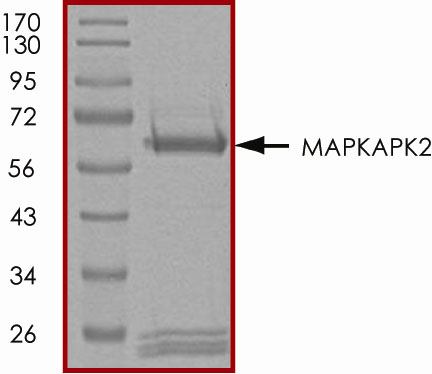Recombinant Human Active MAPKAPK2 (46-end) Protein, CF Summary
Product Specifications
Analysis
Using an N-terminal GST tag
Product Datasheets
Carrier Free
CF stands for Carrier Free (CF). We typically add Bovine Serum Albumin (BSA) as a carrier protein to our recombinant proteins. Adding a carrier protein enhances protein stability, increases shelf-life, and allows the recombinant protein to be stored at a more dilute concentration. The carrier free version does not contain BSA.
In general, we advise purchasing the recombinant protein with BSA for use in cell or tissue culture, or as an ELISA standard. In contrast, the carrier free protein is recommended for applications, in which the presence of BSA could interfere.
3705-KS
| Formulation | Supplied in 50 mM Tris-HCl, pH 7.5, 150 mM NaCl, 10 mM Glutathione, 0.1 mM EDTA, 0.25 mM DTT, 0.1 mM PMSF, 25% glycerol. |
| Shipping | The product is shipped with dry ice or equivalent. Upon receipt, store it immediately at the temperature recommended below. |
| Stability & Storage: | This product is stable at ≤ ‑70 °C for up to 1 year from the date of receipt. For optimal storage, aliquot into smaller quantities after centrifugation and store at recommended temperature. Avoid repeated freeze-thaw cycles. |
Assay Procedure
- Active Kinase - Active MAPKAPK2 (0.1 μg/μL) diluted with Kinase Dilution Buffer III and assayed as outlined in sample activity plot. Note: These are suggested working dilutions and it is recommended that the researcher perform a serial dilution of Active MAPKAPK2 for optimal results.
- Kinase Assay Buffer I - 25 mM MOPS, pH 7.2, 12.5 mM beta -glycerolphosphate, 25 mM MgCl2, 5 mM EGTA, 2 mM EDTA. Add 0.25 mM DTT to the Kinase Assay Buffer prior to use.
- Kinase Dilution Buffer III - Kinase Assay Buffer I diluted at a 1:4 ratio (5X dilution) with 50 ng/μL BSA solution.
- 10 mM ATP Stock Solution - Prepare the ATP Stock Solution by dissolving 55 mg of ATP in 10 mL of Kinase Assay Buffer I. Store 200 μL aliquots at -20 °C.
- [33P]-ATP Assay Cocktail - Prepare 250 μM [33P]-ATP Assay Cocktail in a designated radioactive work area by adding the following components: 150 μL of 10 mM ATP Stock Solution, 100 μL of [33P]-ATP (1 mCi/100 μL), and 5.75 mL of Kinase Assay Buffer I. Store 1 mL aliquots at -20 °C.
- Substrate - HSP27tide synthetic peptide substrate (RRLNRQLSVA-amide) diluted in distilled water to a final concentration of 1 mg/mL.
- Thaw the [33P]-ATP Assay Cocktail in a shielded container in a designated radioactive work area.
- Thaw the Active MAPKAPK2, Kinase Assay Buffer I, Substrate, and Kinase Dilution Buffer on ice.
- In a pre-cooled microfuge tube, add the following reaction components bringing the initial reaction volume up to 20 μL:
a. Diluted Active MAPKAPK2: 10 μL
b. Substrate (1 mg/mL Stock Solution): 5 μL
c. Distilled water (2-8 °C): 5 μL - Set up the blank control as outlined in step 3, excluding the addition of the substrate. Replace the substrate with an equal volume of distilled water.
- Initiate the reaction by the addition of 5 μL [33P]-ATP Assay Cocktail, bringing the final volume up to 25 μL. Incubate the mixture in a water bath at 30 °C for 15 minutes.
- After the 15 minute incubation period, terminate the reaction by spotting 20 μL of the reaction mixture onto individual pre-cut strips of phosphocellulose P81 paper.
- Air dry the pre-cut P81 strip and sequentially wash in a 1% phosphoric acid solution (dilute 10 mL of phosphoric acid and make a 1 liter solution with distilled water) with constant gentle stirring. It is recommended that the strips be washed a total of 3 intervals for approximately 10 minutes each.
- Count the radioactivity on the P81 paper in the presence of scintillation fluid in a scintillation counter.
- Determine the corrected cpm by removing the blank control value (see step 4) for each sample and calculate the kinase specific activity as outlined below.
Calculation of [33P]-ATP Specific Activity (SA) (cpm/pmol)
Specific Activity (SA) = cpm for 5 μL [33P]-ATP/pmol of ATP (in 5 μL of a 250 μM ATP stock solution; i.e. 1250 pmol)
Calculation of Kinase Specific Activity (SA) (pmol/minutes/μg or nmol/minutes/mg)
Corrected cpm from reaction / [(SA of 33P-ATP in cpm/pmol) x (Reaction time in minutes) x (Enzyme amount in μg or mg)] x [(Reaction volume) / (Spot Volume)]
Scientific Data
Reconstitution Calculator
Background: MAPKAPK2
MAPKAPK2 (MAPKAP kinase 2) is a Ser/Thr protein kinase which is regulated via direct phosphorylation by p38 MAP kinase (1). In conjunction with p38 MAP kinase, MAPKAPK2 is known to be involved in many cellular processes including stress and inflammatory responses, nuclear export, gene expression regulation, and cell proliferation. Heat shock protein 27 (HSP27) has been shown to be one of the substrates of MAPKAPK2 in vivo.
Citation for Recombinant Human Active MAPKAPK2 (46-end) Protein, CF
R&D Systems personnel manually curate a database that contains references using R&D Systems products. The data collected includes not only links to publications in PubMed, but also provides information about sample types, species, and experimental conditions.
1 Citation: Showing 1 - 1
-
Phosphorylated recombinant HSP27 protects the brain and attenuates blood-brain barrier disruption following stroke in mice receiving intravenous tissue-plasminogen activator
Authors: Y Shimada, H Shimura, R Tanaka, K Yamashiro, M Koike, Y Uchiyama, T Urabe, N Hattori
PLoS ONE, 2018-05-24;13(5):e0198039.
Applications: Bioassay
FAQs
No product specific FAQs exist for this product, however you may
View all Proteins and Enzyme FAQsReviews for Recombinant Human Active MAPKAPK2 (46-end) Protein, CF
There are currently no reviews for this product. Be the first to review Recombinant Human Active MAPKAPK2 (46-end) Protein, CF and earn rewards!
Have you used Recombinant Human Active MAPKAPK2 (46-end) Protein, CF?
Submit a review and receive an Amazon gift card.
$25/€18/£15/$25CAN/¥75 Yuan/¥2500 Yen for a review with an image
$10/€7/£6/$10 CAD/¥70 Yuan/¥1110 Yen for a review without an image


